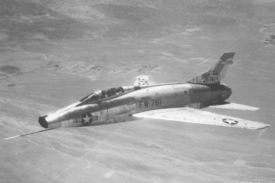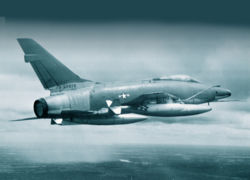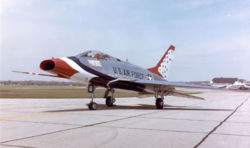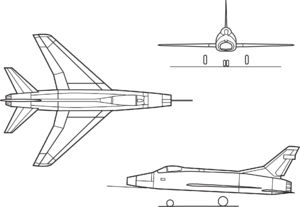PlaneSpottingWorld welcomes all new members! Please gives your ideas at the Terminal.
F-100 Super Sabre
| F-100 Super Sabre | |
|---|---|
| F-100A with the original short tail fin. | |
| Type | Fighter-bomber |
| Manufacturer | North American Aviation |
| Maiden flight | 25 May 1953 |
| Introduced | 27 September 1954 |
| Retired | 1979 (US ANG), 1982 (Turkey) |
| Primary users | United States Air Force France, Denmark, Turkey, Taiwan |
| Produced | 1953-1959 |
| Number built | 2,294 |
| Unit cost | US$697,029 (F-100D)[1] |
| Developed from | F-86 Sabre |
| Variants | North American YF-107 |
The North American F-100 Super Sabre was a jet fighter aircraft that served with the United States Air Force (USAF) from 1954 to 1971 and with the Air National Guard (ANG) until 1979. It was first US fighter capable of supersonic speed in level flight.
The F-100 also served in several NATO air forces and with other US allies. In its later life, it was often referred to as "the Hun," a shortened version of "one hundred." Considered the successor to the F-86 Sabre, it would be largely replaced by the F-4 Phantom II and later, the F-16 Falcon. The F-100 is noted as the first of the Century Series collection of USAF jet fighters.
Contents
Design and development
In January 1951, North American Aviation delivered an unsolicited proposal for a supersonic day fighter to the United States Air Force. Named Sabre 45 because of its 45° wing sweep, it represented an evolution of the F-86 Sabre. The mockup was inspected 7 July 1951 and after over a hundred modifications, the new aircraft was accepted as the F-100 on 30 November 1951. On 3 January 1952, the USAF ordered two prototypes followed by 23 F-100As in February and an additional 250 F-100As in August.
The YF-100A first flew on 25 May 1953, seven months ahead of schedule. It reached Mach 1.05 in spite of being fitted with a de-rated XJ57-P-7 engine. The second prototype flew on 14 October 1953, followed by the first production F-100A on 9 October 1953. The USAF operational evaluation from November 1953 to December 1955 found the new fighter to have superior performance but declared it not ready for widescale deployment due to various deficiencies in the design. These findings were subsequently confirmed during Project Hot Rod operational suitability tests. Particularly troubling was the yaw instability in certain regimes of flight which produced inertia coupling. The aircraft could develop a sudden yaw and roll which would happen too fast for the pilot to correct and would quickly overstress the aircraft structure to disintegration. It was under these conditions that North American's chief test pilot, George Welch, was killed while dive testing an early-production F-100A on 12 October 1954. A related control problem stemmed from handling characteristics of the swept wing at high angles of attack. As the aircraft approached stall speeds, loss of lift on the tips of the wings caused a violent pitch-up.
Nevertheless, delays in the F-84F Thunderstreak program pushed the Tactical Air Command to order the raw F-100A into service. TAC also requested that future F-100s should be fighter-bombers with nuclear bomb capability.
Operational history
The F-100A officially entered USAF service on 27 September 1954 with 479th Fighter Wing at George AFB. By 10 November 1954, the F-100As suffered six major accidents due to flight instability, structural failures, and hydraulic system failures, prompting the Air Force to ground the entire fleet until February 1955. The 479th finally became operational in September 1955. Due to ongoing problems, the Air Force began phasing out the F-100A in 1958, with the last aircraft leaving active duty in 1961. By that time, 47 aircraft were lost in major accidents[1]. Escalating tension due to construction of the Berlin Wall in August 1961 forced the USAF to recall the F-100As into active service in early 1962. The aircraft was finally retired in 1970.
The TAC request for a fighter-bomber was addressed with the F-100C which flew in March 1954 and entered service on 14 July 1955 with 450th Fighter Wing, Foster AFB. Operational testing in 1955 revealed that the F-100C was at best an interim solution, sharing all the vices of the F-100A. The uprated J57-P-21 engine boosted performance but continued to suffer from compressor stalls. On a positive note, the F-100C was considered an excellent platform for nuclear toss bombing because of its high top speed. The inertia coupling problem was more or less addressed with installation of a yaw damper in the 146th F-100C, later retrofitted to earlier aircraft. A pitch damper was added starting with the 301st F-100C, at a cost of US$10,000 per aircraft[1].
The addition of "wet" hardpoints meant the F-100C could carry a pair of 275 US gal (1,040 L) and a pair of 200 US gal (770 L) drop tanks. However, the combination caused loss of directional stability at high speeds and the four tanks were soon replaced by a pair of 450 US gal (1,730 L) drop tanks. The 450s proved scarce and expensive and were often replaced by smaller 335 US gal (1,290 L) tanks. Most troubling to TAC was the fact, that, as of 1965, only 125 F-100Cs were capable of utilizing all non-nuclear weapons in the Air Force inventory, particularly cluster bombs and AIM-9 Sidewinder air-to-air missiles [1]. By the time the F-100C was phased out in June 1970, 85 had been lost in major accidents.
The definitive F-100D aimed to address the offensive shortcomings of the F-100C by being primarily a ground attack aircraft with secondary fighter capability. To this effect, the aircraft was fitted with autopilot, upgraded avionics, and, starting with the 184th production aircraft, the Sidewinder capability. In 1959, 65 aircraft were modified to also fire the AGM-12 Bullpup air-to-ground missile. To further address the dangerous flight characteristics, the wing span was extended by 26 inches (66 cm) and the vertical tail area was increased by 27%.
The F-100D flew on 24 January 1956, entering service on 29 September 1956 with 405th Fighter Wing at Langley AFB. The aircraft suffered from reliability problems with the constant speed drive which provides constant-frequency current to electrical systems. In fact, the drive was so unreliable that USAF required it to have its own oil system to minimize damage in case of failure. Landing gear and brake parachute malfunctions claimed a number of aircraft, and the refueling probes had a tendency to break away during high speed maneuvers. Numerous post-production fixes created such a diversity of capabilities between individual aircraft that by 1965 around 700 F-100Ds underwent High Wire modifications to standardize the weapon systems. High Wire modifications took 60 days per aircraft at a total cost of US$150 million. In 1966, Combat Skyspot program fitted some F-100Ds with an X band radar transmitter to allow for ground-directed bombing in inclement weather or at night.
In 1967, the USAF began a structural reinforcement program to extend the aircraft's service life from the designed 3,000 flying hours to 7,000. Over 500 F-100Ds were lost, predominantly in accidents. After one aircraft suffered wing failure, particular attention was paid to reinforcing the wings with external bracing strips. During the Vietnam War, combat losses constituted as many as 50 aircraft per year. On 7 June 1957, an F-100D fitted with an Astrodyne booster rocket making 150,000 lbf (667.2 kN) of thrust successfully performed a zero length launch. The capability was incorporated into late-production aircraft. After a major accident, the USAF Thunderbirds reverted from F-105 Thunderchief to the F-100D which they operated from 1964 until it was replaced by the F-4 Phantom II in 1968.
The F-100 was the subject of many modification programs over the course of its service. Many of these were improvements to electronics, structural strengthening, and projects to improve maintainability. One of the more interesting of these was the replacement of the original afterburner of the J-57 engine with the more advanced afterburners from retired Convair F-102 Delta Dagger interceptors. This modification changed the appearance of the aft end of the F-100, doing away with the original "petal-style" exhaust. The afterburner modification started in the 1970s and solved maintenance problems with the old type as well as operational problems, incl. compressor stall problems.
The F-100F two-seat trainer entered service in 1958. It received many of the same weapons and airframe upgrades as the F-100D, including the new afterburners. By 1970, 74 F-100Fs were lost in major accidents.
By 1972, the F-100 was mostly phased out of USAF active service. In Air National Guard units, the F-100 was replaced by the F-4, the A-7 Corsair II and the A-10 Thunderbolt II, with the last aircraft retiring in 1979. In foreign service, Danish and Turkisch F-100s soldiered on until 1982.
After the Super Sabres were withdrawn from service a large number of them were converted into remote-controlled drones (QF-100) for use as targets for various antiaircraft weapons, including missile-carrying interceptors.
Project High Wire
High Wire project was a modernization program for selected F-100Cs, Ds and F aircraft. It consisted of two modifications:
- 1) Electrical rewriting upgrade
- 2) Heavy maintenance and IRAN upgrade.
Rewiring upgrade operation consisted of replacing old wiring and harnesses with improved maintainable designs. Heavy maintenance and IRAN included new kits, modifications, standardized configurations, repairs, replacements and complete refurbishment.
This project required all new manuals (TOs) and incremented (i.e. -85 to -86) block numbers. All later production models, especially the F models included earlier High Wire mods. New manuals included colored illustrations. All manuals will have the Roman numeral (I) added after the aircraft number (i.e. T.O 1F-100D(I)-1S-120 12 January 1970). {source/edited: LanceBarber}
Vietnam War
The F-100Ds arrived in Southeast Asia in 1962 and began flying combat missions. On 18 August 1964 the first F-100D flown by 1LT Colin A. Clark, from the 428th TFS, was shot down by ground fire, he ejected and survived. On 04 April 1965 an F-100 Supersabre piloted by Capt. Donald Kilgus shot down one of the first enemy jet aircraft in aerial combat in Vietnam, a Mig-17, using cannon fire. The aircraft was used for ground attack within South Vietnam. The two-seat F-100F operated as a "fast-FAC" (forward air controller) spotting targets for other aircraft. It was also the first Wild Weasel SEAD aircraft whose specially trained crews were tasked with locating and destroying enemy air defenses. Four F-100F Wild Weasel I were fitted with an APR-25 vector radar homing and warning (RHAW) receiver, an IR-133 panoramic receiver with greater detection range, and a KA-60 panoramic camera. The RHAW could detect early warning radars and, most importantly, emissions from SA-2 Guideline tracking and guidance systems. These aircraft deployed to Korat Royal Thai Air Force Base in Thailand in November 1965, and began flying combat missions with 388th Tactical Fighter Wing in December. They were joined by three more aircraft in February 1966. All Wild Weasel F-100Fs were eventually modified to fire the AGM-45 Shrike anti-radiation missile. By war's end, 242 F-100 Super Sabres had been lost in Vietnam, and the F-100 was progressively replaced by the F-4 Phantom II and the F-105 Thunderchief. [2]
Notable achievements
Source: Knaack[1]
- The first operational aircraft in United States Air Force inventory capable of exceeding the speed of sound in level flight.
- On 29 October 1953, the first YF-100A prototype set a world speed record of 755.149 mph (656.207 knots, 1,215.295 km/h) at low altitude.
- On 20 August 1955, an F-100C set the first supersonic world speed record of 822.135 mph (714.416 knots, 1,232.098 km/h).
- On 4 September 1955, an F-100C won the Bendix Trophy, covering 2,235 miles (2,020 nm, 3,745 km) at an average speed of 610.726 mph (530.706 knots, 982.868 km/h).
- On 26 December 1956, two F-100Ds became the first-ever aircraft to successfully perform buddy refueling.
- On 13 May 1957, three F-100Cs set a new world distance record for single-engine aircraft by covering the 6,710 mile (5,835 nm, 10,805 km) distance from London to Los Angeles in 14 hours and 4 minutes. The flight was accomplished using inflight refueling.
- On 7 August 1959, two F-100Fs became the first-ever jet fighters to fly over the North Pole.
- USAF Colonel George E. "Bud" Day, Medal of Honor recipient (for actions in the Vietnam War) and USA's most highly decorated soldier since General Douglas MacArthur, flew F-100s.
- The U.S. Air Force Thunderbirds operated the F-100C from 1956 until 1964. After briefly converting to the F-105 Thunderchief, the team flew F-100Ds from July 1964 until November 1968, before converting to the F-4E Phantom II.
- On 04 April 1965 an F-100 Supersabre piloted by USAF Capt. Donald Kilgus shot down one of the first enemy jets of the Vietnam War,a Mig-17, using cannon fire.
Costs
The costs are in contemporary United States dollars and have not been adjusted for inflation.[1]
| F-100A | F-100C | F-100D | F-100F | |
|---|---|---|---|---|
| R&D | 23.2 million for the program or 10,134 prorated per aircraft | |||
| Airframe | 748,259 | 439,323 | 448,216 | 577,023 |
| Engine | 217,390 | 178,554 | 162,995 | 143,527 |
| Electronics | 8,549 | 12,050 | 10,904 | 13,667 |
| Armament | 19,905 | 21,125 | 66,230 | 66,332 |
| Ordnance | 20,807 | 12,125 | 8,684 | 3,885 |
| Flyaway cost | 1,014,910 | 663,181 | 697,029 | 804,444 |
| Additional modification costs | 224,048 | 110,559 | 105,604 | |
| Cost per flying hour | 583 | 583 | ||
| Maintenance cost per flying hour | 215 | 249 | 249 | 249 |
Variants
- YF-100
- Prototype, later designated TF-100A; two built.
- F-100A
- Single-seat day fighter; 203 built.
- RF-100A (Slick Chick)
- F-100A modified for photoreconnaissance, six modified in 1954 (53-1545,1546,1547,1548,55-1551,55-1554). Unarmed, with camera installations in lower fuselage bay. Retired from USAF service in 1958. Four transferred to Republic of China Air Force, retired in 1960.
- F-100B
- See North American YF-107
- F-100BI
- Proposed interceptor version of F-100B, did not advance beyond mockup.
- F-100C
- Additional fuel tanks in the wings, fighter-bomber capability, probe-and-drogue refueling capability, uprated J57-P-21 engine on late production aircraft. First flight March 1954; 476 built.
- TF-100C
- One F-100C converted into a two-seat training aircraft.
- F-100D
- Single-seat fighter-bomber, more advanced avionics, larger wing and tail fin, landing flaps. First flight 24 January 1956; 1,274 built. One of these is preserved at the Carolinas Aviation Museum.
- F-100F
- Two-seat training version, armament decreased from four to two cannon. First flight 7 March 1957, 339 built.
- DF-100F
- This designation was given to some F-100Fs that were used as drone directors.
- NF-100F
- Three F-100Fs used for test purposes, the prefix N indicates that modifications prevented return to regular operational service.
- TF-100F
- Specific Danish designation given to 14 F-100Fs exported to Denmark in 1974, in order to distinguish these from the six F-100Fs delivered 1959-1961.
- F-100J
- Unbuilt all-weather export version for Japan.
- F-100L
- Unbuilt variant with a J57-P-55 engine.
- F-100N
- Unbuilt version with simplified avionics.
- F-100S
- Proposed French-built F-100F with Rolls-Royce Spey turbofan engine.
Operators
A total of 48 F-100Ds and 24 Fs were delivered to Denmark from 1959 to 1974. The last Danish F-100s were retired from service in 1982. The F-100s were replaced by SAAB F-35 Drakens. Some ex-Danish F-100s were transferred to Turkey.
- France
- Armee de l'Air (100)
Armee de l'Air was the first allied air force to receive the F-100 Super Sabre. The first plane arrived in France on May 1, 1958. 85 F-100Ds and 15 F-100Fs were supplied to France, and assigned to the NATO 4th Allied Tactical Air Force. They were stationed in German French bases. French F-100s were used on combat missions flying from bases in France against targets in Algeria.
In 1967 France left NATO, and German-based F-100s were transferred to France, using bases recently vacated by USAF.
The Chinese Nationalist Air Force (CNAF) was the only allied air force to operate the F-100A model. The first F-100 was delivered in October 1958. It was followed by 15 F-100As in 1959, and by 65 more F-100As in 1960. In 1961, four unarmed RF-100As were delivered. Additionally, 38 ex-ANG F-100As were delivered later, to bring total strength to 118 F-100As and four RF-100As.
Chinese Nationalist Air Force F-100As were retrofitted with the F-100D vertical tail with its AN/APS-54 tail-warning radar and equipped to launch Sidewinder air-to-air missiles.
CNAF F-100s flew intelligence missions over China, and several were lost.
- Turkey
- Turkish Air Force (206)
Turk Hava Kuvvetleri (THK) received about 206 F-100C,D and F Super Sabres. Most came from US stocks, and a few were supplied by Denmark. Turkish F-100s saw extensive action during the 1974 invasion of Cyprus.
Specifications (F-100D)
Data from Quest for Performance[3]
General characteristics
- Crew: 1
- Length: 50 ft (15.2 m)
- Wingspan: 38 ft 9 in (11.81 m)
- Height: 16 ft 2¾ in (4.95 m)
- Wing area: 400 ft² (37 m²)
- Empty weight: 21,000 lb (9,500 kg)
- Loaded weight: 28,847 lb (13,085 kg)
- Max takeoff weight: 34,832 lb (15,800 kg)
- Powerplant: 1× Pratt & Whitney J57-P-21/21A turbojet
- Dry thrust: 10,200 lbf (45 kN)
- Thrust with afterburner: 16,000 lbf (71 kN)
- *Zero-lift drag coefficient: 0.0130
- Drag area: 5.0 ft² (0.46 m²)
- Aspect ratio: 3.76
Performance
- Maximum speed: 750 knots (864 mph, 1,390 km/h)
- Range: 1,733 nm (1,995 mi, 3,210 km)
- Service ceiling: 50,000 ft (15,000 m)
- Rate of climb: 22,400 ft/min (114 m/s)
- Wing loading: 72.1 lb/ft² (352 kg/m²)
- Thrust/weight: 0.55
- Lift-to-drag ratio: 13.9
Armament
- Guns: 4× 20 mm (0.787 in) M39 cannon
- Missiles:
- Bombs: 7,040 lb (3,190 kg) of weapons, including
- Conventional bombs or
- Mark 7 nuclear bomb or
- Mk 28 nuclear bomb or
- Mk 43 nuclear bomb or
- Mk 57 nuclear bomb or
- Mk 61 nuclear bomb nuclear weapons
Avionics
- Minneapolis-Honeywell MB-3 automatic pilot
- AN/AJB-1B low-altitude bombing system
References
- ↑ 1.0 1.1 1.2 1.3 1.4 1.5 Knaack, Marcelle Size. Encyclopedia of US Air Force Aircraft and Missile Systems: Volume 1 Post-World War II Fighters 1945-1973. Washington, DC: Office of Air Force History, 1978. ISBN 0-912799-59-5.
- ↑ Hobson 2002
- ↑ Loftin, LK, Jr. Quest for Performance: The Evolution of Modern Aircraft: NASA SP-468. [1] Access date: 22 April 2006.
- Hobson, Chris. Vietnam Air Losses: United States Air Force, Navy and Marine Corps Fixed-Wing Aircraft Losses in Southeast Asia, 1961-73. North Branch, Minnesota: Specialty Press, 2002. ISBN 1-85780-1156.
External links
- F-100 Serial Database
- F-100 Photo Database
- Project High Wire - Details for the F-100D and C models.
- Warbird Alley: F-100 page - Information about privately-owned F-100s
Related content
Related development
Comparable aircraft
Designation sequence
Related lists
See also
Lists relating to aviation | |
|---|---|
| General | Timeline of aviation · Aircraft · Aircraft manufacturers · Aircraft engines · Aircraft engine manufacturers · Airports · Airlines |
| Military | Air forces · Aircraft weapons · Missiles · Unmanned aerial vehicles (UAVs) · Experimental aircraft |
| Notable incidents and accidents | Military aviation · Airliners · General aviation · Famous aviation-related deaths |
| Records | Flight airspeed record · Flight distance record · Flight altitude record · Flight endurance record · Most produced aircraft |
cs:F-100 Super Sabre da:F-100 Super Sabre de:North American F-100 es:F-100 Super Sabre fr:North American F-100 Super Sabre it:North American F-100 Super Sabre nl:North American F-100 Super Sabre ja:F-100 (戦闘機) no:North American F-100 Super Sabre pl:North American F-100 Super Sabre ru:North American F-100 Super Sabre tr:F-100






